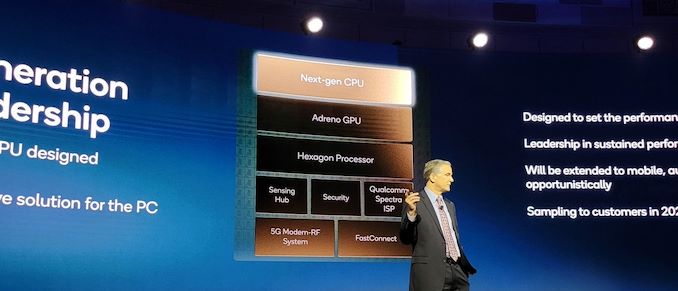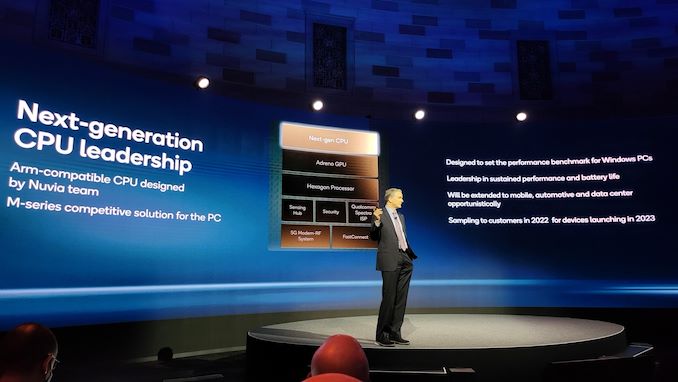Qualcomm x Nuvia: Silicon Sampling in Late 2022, Products in 2023
by Dr. Ian Cutress on November 18, 2021 12:15 PM EST- Posted in
- CPUs
- Snapdragon
- Arm
- Qualcomm
- Laptops
- Notebooks
- Windows on Snapdragon
- NUVIA
- ARMv9

One of the more curious acquisitions in the last couple of years has been that of Nuvia by Qualcomm. Nuvia was a Silicon Valley start-up founded by the key silicon and design engineers and architects behind both Apple’s and Google’s silicon for the past few years. Qualcomm CEO Cristiano Amon made it crystal clear when Nuvia was acquired that they were going after the high-performance ultraportable laptop market, with both Intel and Apple in the crosshairs.
Nuvia came out of stealth in November 2019, with the three main founders having spent almost a year building the company. Gerard Williams III, John Bruno, and Manu Gulati have collectively driven the silicon design of 20+ chips, have combined over 100 patent, and have been in leadership roles across Google, Apple, Arm, Broadcom, and AMD. Nuvia raised a lot of capital, $300M+ over two rounds of funding and angel investors, and the company hired a lot of impressive staff.
The goal of Nuvia was to build an Arm-based general purpose server chip that would rock the industry. Imagine something similar to what Graviton 2 and Ampere Altra are today, but with a custom microarchitecture on par (or better) with Apple’s current designs. When Nuvia was still on its own in start-up mode, some were heralding the team and the prospect, calling for the downfall of x86 with Nuvia’s approach. However, Qualcomm swept in and acquired the company in March 2021, and repurposed Nuvia’s efforts towards a laptop processor.
It’s been no secret that Qualcomm has been after the laptop and notebook market for some time. Multiple generations of ‘Windows on Snapdragon’ have come to market through Qualcomm’s partners, initially featuring smartphone-class silicon before becoming something more bespoke with the 8cx, 8cx Gen 2, and 7c/7 options in the past couple of years. It has taken several years for Qualcomm to get the silicon and the Windows ecosystem somewhere that makes sense for commercial and consumer use, and with the recent news that Windows 11 on these devices now enabling full x86-64 emulation support, the functional difference between a Qualcomm laptop and an x86 laptop is supposed to be near zero. Qualcomm would argue their proposition is better, allowing for 2 days of use on a single charge, holding charge for weeks, and mobile wireless connectivity with 4G/5G. I’ve tested one of the previous generation S855 Lenovo Yoga devices, and the battery life is insane – but I needed better were functional support (turns out I have an abnormal edge-case work flow…) and more performance. While Qualcomm has been working on the former since my last test, and Nuvia is set to bring the latter.

Image from @anshelsag on Twitter, Used with permission
At Qualcomm’s Investor Day this week, the Qualcomm/Nuvia relationship was mentioned in an update. I had hoped that by the end of this year (and Qualcomm’s Tech Summit in only a couple of weeks) that we might be seeing something regarding details or performance, however Qualcomm is stating that its original schedule is still on track. As announced at the acquisition, the goal is to deliver test silicon into the hands of partners in the second half of 2022.
The goal here is to have laptop silicon that is competitive with Apple's M-series, but running Windows. This means blowing past Intel and AMD offerings, and coupled with the benefits of better battery life, sustained performance, and mobile connectivity. From the disclosures so far, it’s perhaps no surprise that the Nuvia CPUs will be paired with an Adreno GPU and a Hexagon DSP, although it will be interesting to see if the Nuvia CPU is a single big core paired with regular Arm efficient cores, or everything in the CPU side will be new from the Nuvia team.
I have no doubt that at Qualcomm’s Tech Summit in December 2022 we’ll get a deeper insight into the microarchitecture of the new core. Either that or Qualcomm might surprise us with a Hot Chips presentation in August. With regards to going beyond laptop chips, while Qualcomm is happy to state that Nuvia's designs will be 'extended to [other areas] opportunistically', it's clear that they're locking the crosshairs on the laptop market before even considering what else might be in the field of view.










50 Comments
View All Comments
Raqia - Thursday, November 18, 2021 - link
They had a nice preview of "next-gen" snapdragon performance against what is likely the A15's GPU on page 18 of Jim Thompson's slides:https://d1io3yog0oux5.cloudfront.net/_33a7aedec0c1...
The sustained performance is formidable this gen. despite what is still likely to be handicap of Samsung's 4nm process vs TSMC's 5nm.
Page 19's projections for Adreno GPUs performance in PC laptops is 15+ TFLOPs which greatly exceeds even the M1Max's throughput, so that number seems wildly ambitious for now, although I'm sure the M2Max will be in that neighborhood by 2023.
ikjadoon - Thursday, November 18, 2021 - link
Odd to see no power nor thermal data on the chart. Looking at last year, Qualcomm’s Adreno 660 (SD888) had very high power draw, so is this next-gen “Adreno 670” actually more efficient or are they letting it run hotter for longer?Cooling design is also key: identical test bench or two phones?
“The Snapdragon 888’s peak performance state is pretty absurd, as at its 840MHz GPU frequency I’ve measured average power of around 11W.”
11W pains me. I really hope Qualcomm can teach Apple, the king of GPU throttling, a lesson in sustained perf this year.
From: https://www.anandtech.com/show/16463/snapdragon-88...
Before I forget: And people complained Apple didn’t label their graphs... 😅
Raqia - Thursday, November 18, 2021 - link
Agree w/ your points, it's just a tease. We'll see in about 2 weeks what they have in store, and it's been rumored that this "Adreno 730" is an entirely new architecture after the relatively long in the tooth but prolific 6xx line all the way from the Snapdragon 845.Ppietra - Thursday, November 18, 2021 - link
Anything can scale up! Apple GPU is supposedly going to scale up to 40+ TFLOPs, and that is based on a GPU from 2020.dotjaz - Sunday, January 2, 2022 - link
You obviously don't know anything. Scaling up is hard. Interconnect and synchronisation is very hard, harder than the cores even. ARM even resorted to uncore boosting because they can't scale up their geometry and command pipeline.Anything can scale **DOWN**
darkich - Friday, November 19, 2021 - link
There's nothing wildly ambitious about that since Andreno in SD 888+ reaches almost 2TFLOPS at under 10W peak power.. and Qualcomm already reached 2.6TFLOPS in an OLD 8cx designed for 15W TDP.As Apple's M1 demonstrated, arm chips can scale pretty much linearly.
Raqia - Friday, November 19, 2021 - link
GPUs (not ARM) can scale very nicely with clock-speed or die area due to the embarrassingly parallel nature of rendering. However, pushing clock speed doesn't linearly scare with power consumption, adding GPU blocks increases power, and die area for their likely design is shared with multiple other blocks and caches:https://image.itmedia.co.jp/l/im/ee/articles/2012/...
If you want to do 15 TFLOPS in a reasonable die area and target ~15-30W for a laptop, it would be very ambitious compared to current offerings. The 6XX Adreno is already very efficient relative to other designs iso-process, but scaling the 6XX to 15 TFLOPS would put them in the 80W range (on Samsung's current leading edge process.) They'd likely need the whole 8cx die for just the GPU as well.
yeeeeman - Thursday, April 28, 2022 - link
Unfortunately this comment didn't age well. The new adreno GPU is indeed much much stronger than previous gen and fights shoulder to shoulder with the a15 GPU but power and thermals are so bad that Qualcomm is forced to switch back to tsmc (plus also yields are a big issue with Samsung 4lpe).Luis Alejandro Masanti - Thursday, November 18, 2021 - link
My big question is: December 2022 Qualcomm-Nuvia's chips will be better than Apple's… November 2020's M1… October 2021's M1 Pro/Max… 2022's M… (for MacPros)… or even 2022's M2 chips?Teckk - Thursday, November 18, 2021 - link
When they’re targeting a product release for 2023, why would they plan to target a product from 2021 let alone 2020? They need to be better at perf/watt against Apple, Intel and AMD. I’m sure those smart folks would know that and have a competitive silicon by end of next year.Ever though they come with great credentials, matching/beating Apple silicon for Nuvia with their v1 outing seems pretty monumental. Will be delighted to see more competition though.